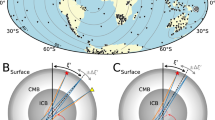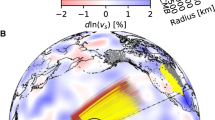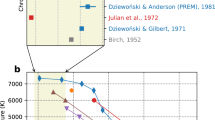Abstract
Knowledge of the seismic structure of the innermost inner core is important for understanding the formation of the inner core1,2,3. It has been suggested recently that this region may exhibit distinct seismic anisotropy4,5. Here, we use the difference in travel times between seismic waves reflected at the underside of the inner core boundary and those traversing the inner core to constrain the seismic anisotropy. We calculated travel-time residuals for waves generated by two deep earthquakes that occurred in Indonesia and Argentina respectively, recorded by seismic arrays in Venezuela and China. The travel-time residuals are systematically larger, by about 1.8 s, for waves that travel roughly along the equatorial plane of the inner core (Indonesia–Venezuela) than for those travelling in a direction at an angle of ∼28∘ to the equatorial plane (from Argentina to China). The difference in travel times is arguably most sensitive to the structure near the centre of the Earth, and thus provides evidence for deep layering within the inner core. Our results are consistent with models invoking seismic anisotropy of the innermost inner core with the slowest direction tilted at an angle of ∼45∘ to the equatorial plane4.
This is a preview of subscription content, access via your institution
Access options
Subscribe to this journal
Receive 12 print issues and online access
$259.00 per year
only $21.58 per issue
Buy this article
- Purchase on Springer Link
- Instant access to full article PDF
Prices may be subject to local taxes which are calculated during checkout




Similar content being viewed by others
References
Jacobs, J. A. The Earth’s Inner Core. Nature 172, 297–298 (1953).
Buffett, B. A. in Earth’s Deep Interior: Mineral Physics and Seismic Tomography From the Atomic to Global Scale Vol. 117 (eds Karato, S. et al.) 37–62 (Geophys. Monogr. Ser., AGU, Washington, 2000).
Yoshida, S., Sumita, I. & Kumazawa, M. Growth model of the inner core coupled with the outer core dynamics and the resulting elastic anisotropy. J. Geophys. Res. 101, 28085–28104 (1996).
Ishii, M. & Dziewonski, A. M. The innermost inner core of the earth: Evidence for a change in anisotropic behaviour at the radius of about 300 km. Proc. Natl Acad. Sci. 99, 14026–14030 (2002).
Beghein, C. & Trampert, J. Robust normal mode constraints on inner-core anisotropy from model space search. Science 299, 552–555 (2003).
Niu, F. & Wen, L. Hemispherical variations in seismic velocity at the top of the Earth’s inner-core. Nature 410, 1081–1084 (2001).
Creager, K. C. Anisotropy of the inner core from differential travel times of the phases PKP and PKIKP. Nature 356, 309–314 (1992).
Tanaka, S. & Hamaguchi, H. Degree one heterogeneity and hemispherical variation of anisotropy in the inner core from PKP(BC)–PKP(DF) times. J. Geophys. Res. 102, 2925–2938 (1997).
Breger, L., Tkalcic, H. & Romanowicz, B. The effects of D on PKP (AB-DF) travel time residuals and implications for inner core structure. Earth Planet. Sci. Lett. 175, 133–143 (2000).
Aki, K. & Richards, P. G. Quantitative Seismology (W. H. Freeman, New York, 1980).
Dziewonski, A. M., Chou, T.-A. & Woodhouse, J. H. Determination of earthquake source parameters from waveform data for studies of global and regional seismicity. J. Geophys. Res. 86, 2825–2852 (1981).
Dziewonski, A. M. & Anderson, D. L. Preliminary reference Earth model. Phys. Earth Planet. Inter. 25, 297–356 (1981).
Takeuchi, N., Geller, R. J. & Cummins, P. R. Highly accurate P-SV complete synthetic seismograms using modified DSM operators. Geophys. Res. Lett. 23, 1175–1178 (1993).
Choy, G. L. & Richards, P. G. Pulse distortion and Hilbert transformation in multiply reflected and refracted body waves. Bull. Seismol. Soc. Am. 65, 55–70 (1975).
Brune, J. N., Nafe, J. E. & Alsop, L. E. The polar phase shift of surface waves on a sphere. Bull. Seismol. Soc. Am 51, 247–257 (1961).
Rial, J. & Cormier, V. Seismic waves at the epicentre’s antipode. J. Geophys. Res. 85, 2661–2668 (1980).
Schimmel, M. & Paulssen, H. Noise reduction and detection of weak, coherent signals through phase-weighted stacks. Geophys. J. Int. 130, 497–505 (1997).
Fukao, Y., Widiyantoro, S. & Obayashi, M. Stagnant slabs in the upper and lower mantle transition zone. Geophys. Rev. 39, 291–323 (2001).
Garnero, E. J. & Thorne, M. in Earth’s ULVZ: Ultra-Low Velocity Zone, in Encyclopedia of Geomagnetism and Paleomagnetism (eds Gubbins, D. & Herrero-Bervera, E.) (Springer, Netherlands, 2008).
Kennett, B. L. N. & Gudmundsson, O. Ellipticity corrections for seismic phases. Geophys. J. Int. 127, 40–48 (1996).
Souriau, A. & Souriau, M. Ellipticity and density at the inner core boundary from subcritical PKiKP and PcP data. Geophys. J. Int. 98, 39–54 (1989).
Wen, L. & Niu, F. Seismic velocity and attenuation structures in the top of the Earth’s inner core. J. Geophys. Res. 107, doi:10.1029/2001JB000170 (2002).
Vidale, J. E. & Earle, P. S. Fine-scale heterogeneity in the Earth’s inner core. Nature 404, 273–275 (2000).
Morelli, A., Dziewonski, A. M. & Woodhouse, J. H. Anisotropy of the inner core inferred from PKIKP travel times. Geophys. Res. Lett. 13, 1545–1548 (1986).
Shearer, P. M., Toy, K. M. & Orcutt, J. A. Axi-symmetric Earth models and inner-core anisotropy. Nature 333, 228–232 (1988).
Creager, K. C. in Earth’s Deep Interior: Mineral Physics and Seismic Tomography From the Atomic to Global Scale Vol. 117 (eds Karato, S. et al.) 89–114 (Geophys. Monogr. Ser., AGU, Washington, 2000).
Cormier, V. F. & Stroujkova, A. Waveform search for the innermost inner core. Earth Planet. Sci. Lett. 236, 96–105 (2005).
Steinle-Neumann, G., Stixrude, L., Cohen, R. E. & Gulseren, O. Elasticity of iron at the temperature of the Earth’s inner core. Nature 413, 57–60 (2001).
Belonoshko, A., Skorodumova, V., Rosengren, A. & Johansson, B. Elastic anisotropy of Earth’s inner core. Science 319, 797–800 (2008).
Grand, S. P. Mantle shear-wave tomography and the fate of subducted slabs. Phil. Trans. R. Soc. A 360, 2475–2491 (2002).
Acknowledgements
We thank the BOLIVAR team, FUNVISIS (Venezuelan Foundation for Seismological Research) and CEA (China Earthquake Administration) for providing the data, N. Takeuchi for providing the DSM code and H. Kawakatsu and S. Tanaka for helpful discussions. This work is supported by Rice University and the NSF.
Author information
Authors and Affiliations
Corresponding author
Rights and permissions
About this article
Cite this article
Niu, F., Chen, QF. Seismic evidence for distinct anisotropy in the innermost inner core. Nature Geosci 1, 692–696 (2008). https://doi.org/10.1038/ngeo314
Received:
Accepted:
Published:
Issue Date:
DOI: https://doi.org/10.1038/ngeo314
This article is cited by
-
Superionic effect and anisotropic texture in Earth’s inner core driven by geomagnetic field
Nature Communications (2023)
-
Equatorial anisotropy in the inner part of Earth’s inner core from autocorrelation of earthquake coda
Nature Geoscience (2015)
-
Tectonic history of the Earth’s inner core preserved in its seismic structure
Nature Geoscience (2009)



